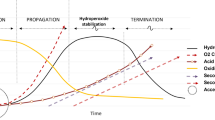Abstract
In the present study, the effects of different ratios of milk phospholipids, cholesterol and phytosterols (Campesterol) powder (50–100%, 0–50%, and 0–50%, respectively) and sonication time (20, 25, 30, 35 and 40 min) were investigated to produce a new formulation of nanoliposomes for encapsulation of vitamin C. The results showed that increasing the time of sonication and decreasing the ratio of phospholipid to phytosterol significantly decreased nanoliposomes’ particle size (p < 0.05). The maximum encapsulation efficiency was obtained at 35 and 40 min of sonication time and 75–25 ratio of phospholipid: phytosterol. Also, reducing the sonication time in the same ratio of phospholipid/phytosterol caused to increase the controlled release. The highest stability of vitamin C during 20 days was obtained in the ratio of 75–25 (phospholipids: campesterol). The results showed a positive effect of cholesterol replacement with campesterol on encapsulation efficiency, control release and stability of vitamin C in nanoliposomes.





Similar content being viewed by others
References
Alexander M, Acero Lopez A, Fang Y, Corredig M. Incorporation of phytosterols in soy phospholipids nanoliposomes: Encapsulation efficiency and stability. LWT-Food Sci. Technol. 47: 427–436 (2012)
AOAC. Official Method of Analysis of AOAC Intl. 18th ed. Method 967.21. Association of Official Analytical Chemists, Arlington, VA, USA (2005)
Barbosa-Canovas GV, Mortimer A, Lineback D, Spiess W, Buckle K, Colonna P. Global Issues In Food Science and Technology. Academic Press. Pullman, WA, USA. pp. 411–424 (2009)
Farhang B, Kakuda Y, Corredig M. Encapsulation of ascorbic acid in liposomes prepared with milk fat globule membrane-derived phospholipids. Dairy Sci. Technol. 92: 353–366 (2012)
Fox PF, Uniacke-Lowe T, McSweeney PLH, O’Mahony JA (2015) Dairy Chemistry and Biochemistry. 2 ed. Springer, Cham. pp. 145-239
Laouini A, Jaafar-Maalej C, Limayem-Blouza I, Sfar S, Charcosset C, Fessi H. Preparation, characterization and applications of liposomes: state of the art. J. Colloid Sci. Biotechnol. 1: 147–168 (2012)
Liu W, Tian M, Kong Y, Lu J, Li N, Han J. Multilayered vitamin C nanoliposomes by self-assembly of alginate and chitosan: long-term stability and feasibility application in mandarin juice. LWT-Food Sci. Technol. 75: 608–615 (2017)
Mohammadi M, Ghanbarzadeh B, Hamishehkar H. Formulation of nanoliposomal vitamin D3 for potential application in beverage fortification. Adv. Pharm. Bull. 4: 569–575 (2014)
Mozafari MR, Johnson C, Hatziantoniou S, Demetzos C. Nanoliposomes and their applications in food nanotechnology. J. Liposome Res. 18: 309–327 (2008)
Ostlund RE. Phytosterols in human nutrition. Annu. Rev. Nutr. 22: 533–549 (2002)
Pezeshky A, Ghanbarzadeh B, Hamishehkar H, Moghadam M, Babazadeh A. Vitamin A palmitate-bearing nanoliposomes: preparation and characterization. Food Biosci. 13: 49–55 (2016)
Quilez J, Garcia-Lorda P, Slas-Salvado J. Potential uses and benefits of phytosterols in diet: present situation and future directions. Clin. Nutr. 22: 343–351 (2003)
Richardson ES, Pitt WG, Woodbury DJ. The role of cavitation in liposome formation. Biophys. J. 93: 4100–4107 (2007)
Schroeder A, Kost J, Barenholz Y. Ultrasound, liposomes, and drug delivery: principles for using ultrasound to control the release of drugs from liposomes. Chem. Phys. Lipids 162: 1–16 (2009)
Sekhon BS. Food nanotechnology—an overview. Nanotechnol. Sci. Appl. 3: 1–15 (2010)
Thompson AK, Hindmarsh JP, Haisman D, Rades T, Singh H. Comparison of the structure and properties of liposomes prepared from milk fat globule membrane and soy phospholipids. J. Agric. Food Chem. 54: 3704–3711 (2006)
Viriyaroj A, Ngawhirunpat T, Sukma M, Akkaramongkolporn P, Ruktanonchai U, Opanasopit P. Physicochemical properties and antioxidant activity of gamma-oryzanol-loaded liposome formulations for topical use. Pharm. Dev. Technol. 14: 665–671 (2009)
Wechtersbach L, Poklar Ulrih N, Cigić B. Liposomal stabilization of ascorbic acid in model systems and in food matrices. LWT-Food Sci. Technol. 45: 43–49 (2012)
Wu Z, Guan R, Lyu F, Liu M, Gao J, Cao G. Optimization of preparation conditions for lysozyme nanoliposomes using response surface methodology and evaluation of their stability. Molecules 21: 741–753 (2016)
Yang JH, Lee SY, Han YS, Park KC, Choy JH. Efficient transdermal penetration and improved stability of L-ascorbic acid encapsulated in an inorganic nanocapsule. Bull. Korean Chem. Soc. 24: 499–503 (2003)
Yang S, Liu C, Liu W, Yu H, Zheng H, Zhou W, Hu Y. Preparation and characterization of nanoliposomes enencapsulation medium-chain fatty acids and vitamin C by lyophilization. Int. J. Mol. Sci. 4: 19763–19773 (2013)
Acknowledgements
The authors are grateful to the Biotech center of Urmia University for allowing them to use that center’s laboratory facilities and equipment during this research.
Author information
Authors and Affiliations
Corresponding author
Rights and permissions
About this article
Cite this article
Amiri, S., Rezazadeh-Bari, M., Alizadeh-Khaledabad, M. et al. New formulation of vitamin C encapsulation by nanoliposomes: production and evaluation of particle size, stability and control release. Food Sci Biotechnol 28, 423–432 (2019). https://doi.org/10.1007/s10068-018-0493-z
Received:
Revised:
Accepted:
Published:
Issue Date:
DOI: https://doi.org/10.1007/s10068-018-0493-z




